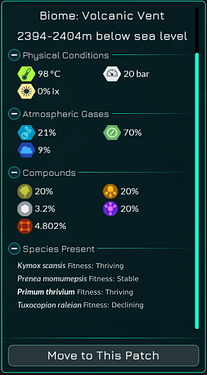I had very similar thoughts in this thread (in the “What’s at Stake in the Early Game” section): Complete Vision of Progression in the Microbe Stage
I’m obviously biased in saying that I think the entire post contains things to have in mind as we conceptualize Thrive, but I’ll quote the relevant part at the bottom of this post so you don’t have to go through everything.
I do like your line of thinking and agree. Ultimately, it comes down to the fact that population isn’t the end-all-be-all “performance metric” for evolution - “fitness” is as Darwin describes. Population can be indicative of an organism’s fitness, but it isn’t necessarily a direct reflection of it. It’s kind of like how GDP is indicative of a country’s economic prosperity, but isn’t necessarily an accurate metric: there’s distribution of wealth, market size, etc. So it’s a bit challenging to deal with that dynamic in Thrive, and I do agree that we should include other metrics in determining a player’s success.
With population essentially being the fundamental metric of success, I think it’s also important to clarify exactly what a “good performance” and a “bad performance” in the Microbe Stage is. We obviously want to make it so that success in the early game rewards a player in the future, but not make it so that a player with a less than ideal start has an absolutely miserable playthrough. The post I have linked discusses that as well (I apologize if I am acting self-righteous when mentioning my post lol). I am thinking that having more success in the early game allows greater room for experimentation in evolution, as obviously, you can afford to die more with a bigger population. But looking at things from another perspective, wouldn’t players with less success be served better with a greater ability to experiment with evolution? It’s a very important question to ask.
What is at Stake in the Early Game?
Before delving into the strategy behind the prokaryotic stage, let’s clearly establish the risks and the rewards at stake as a result of the player’s performance in the early stages. In Civilization, the reward is an abundance of resources and territory, which makes the development of science, culture, and military power much easier throughout at least the first half of the game. The risk, on the other hand, is letting go of these benefits, and thus, being at a weaker position to wage war, develop culture, and research in comparison to other players. The ideal is becoming a superpower, the worry is becoming a Civilization which is easy to bully.
In Thrive, the ultimate risk is extinction, so the reward should be a state which minimizes the risk of extinction: a high population. Population is a somewhat finicky performance metric however because as your creature increases in complexity, its population will naturally decrease as well; it doesn’t necessarily mean the player is less successful or is at an exponentially higher risk of extinction. In fact, fitness is perhaps the objective standard of measuring a species’s potential success in evolution, whereas population is a performance metric which could be, but isn’t necessarily, an indicator of high fitness. So there’s an ambiguous balance there between losses which come as a result of worse performance, and losses which are inevitable.
As such, before we discuss strategy, it might be worthwhile to pay a bit more attention to clarifying the impact of the performance metric - population - to the player. Here are some ways I think we can achieve this…
- Explicitly Tell the Player How Many “Lives” They Have - Having a bigger population lets the player die more without risk of extinction, but the amount of times the player can die isn’t very clear. We should somehow let the player know that at x population, they have y amount of lives.
- Let the Player Play in any Species-Inhabited Patch - Already planned, this will add a tangible reward to higher population distributions. Instead of having to move around the map patch-by-patch and having to react to each patch on the way, the player can hunker down in a specific patch and make their species adapt to the environment they feel is most stable. This should probably be coupled with an increase in non-player guided migrations. (Already In)
- Reduce Total Population Lost from a Death at Higher Complexity Levels - This shouldn’t be too lenient, but it emphasizes the fact that, rather than raw population numbers, fitness is the ultimate indicator of survival.
The above should provide tangible benefits and a fair balance behind population which reflects its role in evolution: a performance metric, but not necessarily the most definitive indicator of a species’s success. It also provides a clear reward for the player which will last for at least the entire microbe stage. Since it becomes harder to rapidly gain population as time goes on in the microbe stage…
- A more successful beginning will result in a higher population, which means more lives as you begin to experiment and gain complexity, which means a bigger cushion between the player and the losing condition: extinction.
- A less successful beginning will result in a lower population, which means less lives as you begin to experiment and gain complexity, which means a smaller cushion between the player and the losing condition: extinction.

